RENO, Nev.--(BUSINESS WIRE)--Scientists at the Climate Forecast Applications Network (CFAN) explain why the 2017 Atlantic hurricane season was so active. These insights are providing the basis for models that produce more accurate longer-range forecasts of these storms.
The public focuses on individual storms, but seasonal forecasts are important for the insurance and financial sectors.
Summary of the 2017 hurricane season
The 2017 North Atlantic hurricane season was unusually active:
- In June, CFAN correctly predicted that three hurricanes would make landfall in the United States. The average is 1.5 from 1980 to 2016.
- The 2017 season had an Accumulated Cyclone Energy (ACE) of 226 vs. an average of 105 from 1980 to 2016. It ranks seventh in activity since 1920, and far exceeded predictions.
Why was the 2017 season so active?
CFAN’s forensic analysis of the 2017 season found several factors at work.
The El Niño – Southern Oscillation (ENSO) has a large effect on North Atlantic hurricane activity. A strong hurricane season typically follows a late summer La Niña. Cooling in the tropical eastern Pacific Ocean in early summer was of a magnitude not seen for several decades. However, the developing La Nina explained a relatively small amount of the elevated hurricane activity.
The Atlantic and Pacific Meridional Modes (AMM and PMM) describe ocean and atmosphere weather patterns in the tropical Atlantic and eastern Pacific. During 2017, the PMM boosted hurricane activity in the Gulf of Mexico. The interaction of the PMM and AMM strengthened the hurricanes of the 2017 season.
CFAN has identified a new circulation pattern in the Arctic that has a close relationship with the number of U.S. landfalls. The underlying processes are the subject of active research. Identification of this circulation pattern was a factor in CFAN’s forecast of an active 2017 season, particularly the U.S. landfalls.
This study also identified important atmospheric circulation patterns in the Gulf of Mexico and the western subtropical Pacific, showing how they contributed to 2017’s storms. CFAN’s Jim Johnstone, lead author on the study, says, “Remarkably, this pattern was already established in early summer, before development of La Niña and strong late-summer hurricane activity. This is potentially an important new predictor of Atlantic seasonal hurricane activity.”
Looking to the future
In the past, active hurricane seasons have occurred consecutively, as in 1998-99 and 2003-05. CFAN’s tropical forecast team will watch and report on developments.
Although seasons vary in activity, new research is allowing increasingly reliable forecasts to be made before the start of the North Atlantic hurricane season. CFAN’s President Judith Curry says, “Continued progress will allow useful forecasts for one, two, or even three seasons ahead – allowing for better preparation.”
Additional information and interviews are available on request.
See a preprint copy of the paper here: https://www.cfanclimate.net/copy-of-hurricane-report-form
About CFAN
Climate Forecast Applications Network (CFAN) is owned and operated by climate scientists. CFAN was founded in 2006 by Judith Curry and Peter Webster and launched under Georgia Tech’s Enterprise Innovation Institute VentureLab program. CFAN’s world-class research team translates the latest research and forecast innovations into solutions for our clients’ most challenging weather and climate related problems.
CFAN issues seasonal hurricane forecasts for the Atlantic in December, March, May and August. CFAN’s seasonal hurricane forecast reports are available through paid subscription. See the CFAN website for more information about the firm, its research and forecast products: https://www.cfanclimate.net/





